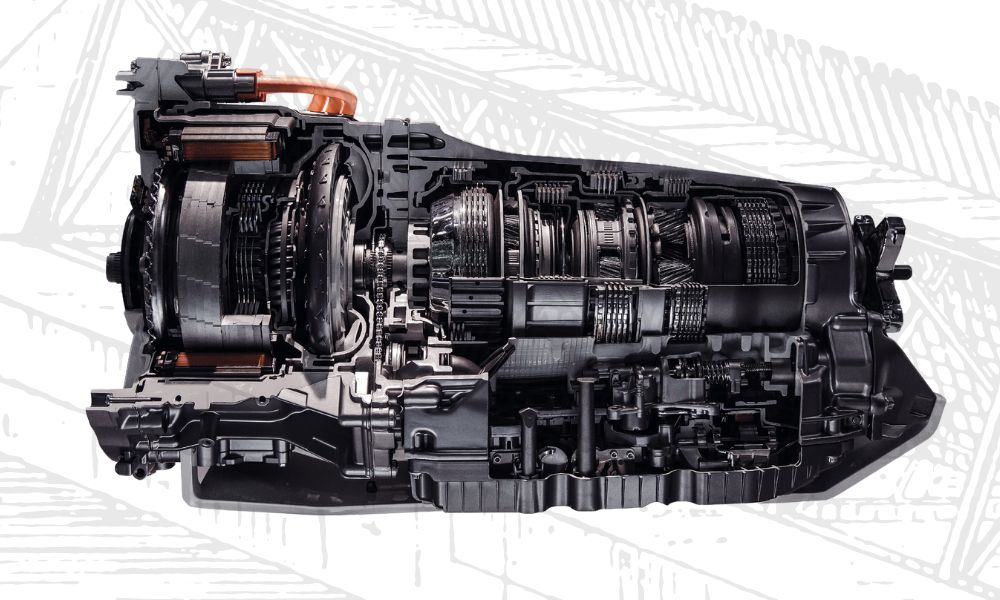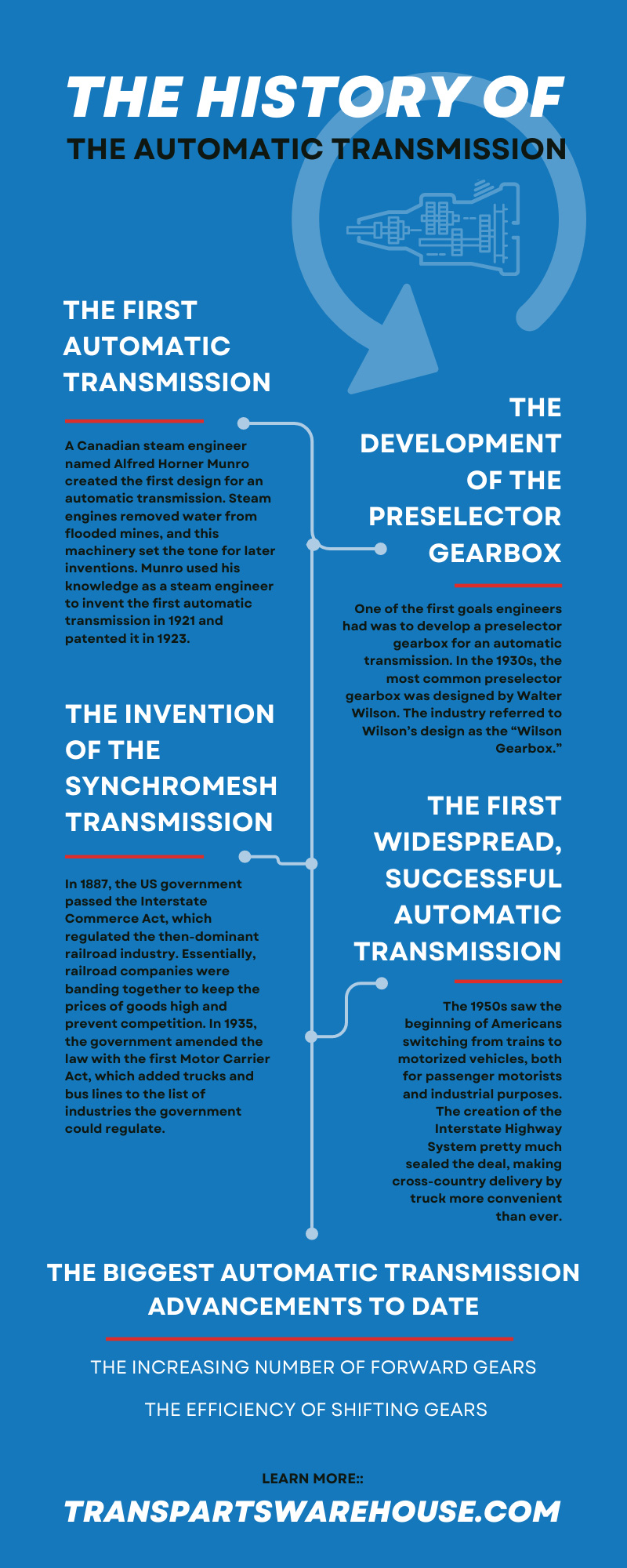
Manual transmission made it more difficult for everyone to learn how to drive. It required more skills and made driving less accessible. But the development of the automatic transmission changed everything. People who wanted to learn how to drive could easily do so. The ability to shift gears and change speeds instantaneously without manual effort was a dream!
But where did automatic transmissions come from? How did they evolve? Read about the history of automatic transmissions and expand your car knowledge!
The Various Attempts at Automatic Vehicles
The goal was to create a vehicle that required no manual shifting gears. This invention didn’t happen overnight. It took decades to perfect the craft and achieve the modern automatic transmission. There were multiple attempts that led us to the modern vehicles we drive today. Let’s take a look at them.
The First Automatic Transmission
Automatic transmissions today function using hydraulic fluid. However, that isn’t how the first transmission worked.
A Canadian steam engineer named Alfred Horner Munro created the first design for an automatic transmission. Steam engines removed water from flooded mines, and this machinery set the tone for later inventions. Munro used his knowledge as a steam engineer to invent the first automatic transmission in 1921 and patented it in 1923.
Munro’s automatic transmission consisted of four forward gears that used compressed air for power. There wasn’t a reverse or parking gear in this transmission model. The air provided minimal power; therefore, Munro’s design didn’t become a commercially sold product. Instead, it became an inspiration for developments to follow.
The Development of the Preselector Gearbox
Manual vehicles lacked gear synchronizers. Today, automatic vehicles use gear synchronizers to line up the shift so the car seamlessly switches into the correct gear.
One of the first goals engineers had was to develop a preselector gearbox for an automatic transmission. In the 1930s, the most common preselector gearbox was designed by Walter Wilson. The industry referred to Wilson’s design as the “Wilson Gearbox.”
The Wilson Gearbox consisted of four forward gears. At this time, most vehicles only had a three-speed gearbox. Additionally, the design implemented a reverse speed. The floorboard had three pedals: gas, brake, and shift. The shift pedal was where the clutch pedal would typically be in a manual vehicle.
This mechanism eliminated the driver’s need to perfectly time the gearshift. Instead, the driver could pre-select the gear while remaining in the current gear. Then, they could press the gear change pedal at the desired moment to switch gears easily.
This was a step in the right direction. It still required drivers to put in some effort when it came to shifting gears. They needed to pay attention to the road ahead to anticipate hills and upcoming stops. Nonetheless, it removed some of the additional complications of timing gearshifts that many drivers found difficult.
The Invention of the Synchromesh Transmission
Hydraulics engineer Earl A. Thompson applied for a patent in 1918 to build a form of transmission that would utilize a synchronizer and match each new speed. As a mechanical and electrical engineer, Thompson’s goal was to give drivers the ability to drive with minimal intervention, like in past models.
The synchronization technology allowed the gears to change without requiring the driver to match the speed. There wasn’t a need to de-clutch with this invention. When the main shaft rotated, the synchronizer rotated alongside it, so the vehicle moved at the desired speed. As the speed changed, the gears smoothly shifted into place.
This invention prevented grinding gears and clanging from the transmission. Furthermore, it made driving a breeze since the driver no longer needed to manually synchronize the transmission’s gears.
The First Widespread, Successful Automatic Transmission
The world saw various types of automatic transmissions before the one that would rule the nation came about. While Thompson originally partnered with Cadillac for the development of the transmission, he later sold the patent to General Motors in 1934.
General Motors soon released a modern version derived from Thompson’s synchromesh transmission design. This model, the original Hydra-Matic, revolutionized automatic transmissions.
The 1940 Oldsmobile was the first vehicle produced with the Hydra-Matic or synchromesh design. Consumers loved the convenience of an automatic transmission that required the slightest effort to switch gears and change speeds.
The four-speed vehicle was an incredible innovation! There was no longer a clutch pedal in the floorboard. Now, only the gas and brake pedals remained. All drivers needed to worry about was controlling their speed and steering the vehicle in the proper direction.
The Hydra-Matic transformed the automotive world. Although it wasn’t the first automatic transmission ever made, it established the foundation of automatic vehicles and allowed engineers to make improvements down the road.
The Biggest Automatic Transmission Advancements to Date
The release of the Hydra-Matic Oldsmobile greatly contributed to General Motors’ success. After that, others began to try out the technique on their own vehicles, and they made gradual improvements over the years to perfect the design. There have been two primary advancements since the original automatic transmission hit the market.
The Increasing Number of Forward Gears
At the start of automatic transmission development, the forward gears were typically only three or four speeds. But during the 1990s, mechanical engineers made various improvements to increase the number of forward gears. Automatic cars would have five or six speeds available.
Then, in the 2000s, more vehicles appeared on the market with seven and eight speeds. This gave vehicles greater power and improved efficiency.
The Efficiency of Shifting Gears
The next incredible advancement was the growth of automatic transmission efficiency. In the past, fuel efficiency wasn’t a concern. Mechanical engineers originally just had the goal of creating a fully functional automatic transmission. Today, engineers can prioritize perfecting transmissions to make consumers’ lives easier.
With the increasing number of forward gears, there are more opportunities for efficiency. The variety of gear ratios creates a unique gear designed for speed.
One newer component in automatic transmissions is the continuously variable transmission (CVT). This feature has an infinite gear ratio to achieve peak performance. Vehicles with CVT drive smoothly, quickly respond to acceleration, and provide more efficient fuel economy.
Automatic transmissions continue to improve as time progresses. After reading this history of automatic transmissions, you can grow your appreciation for the struggles engineers faced before.
You may even be inspired to repair transmission complications on your own, too. If you ever need an automatic transmission parts supplier, Transparts Warehouse is the place for you! Our company has a wide selection of high-quality items. From torque converters to transmission coolers, we have just what you require to get your automatic transmission up and running.


